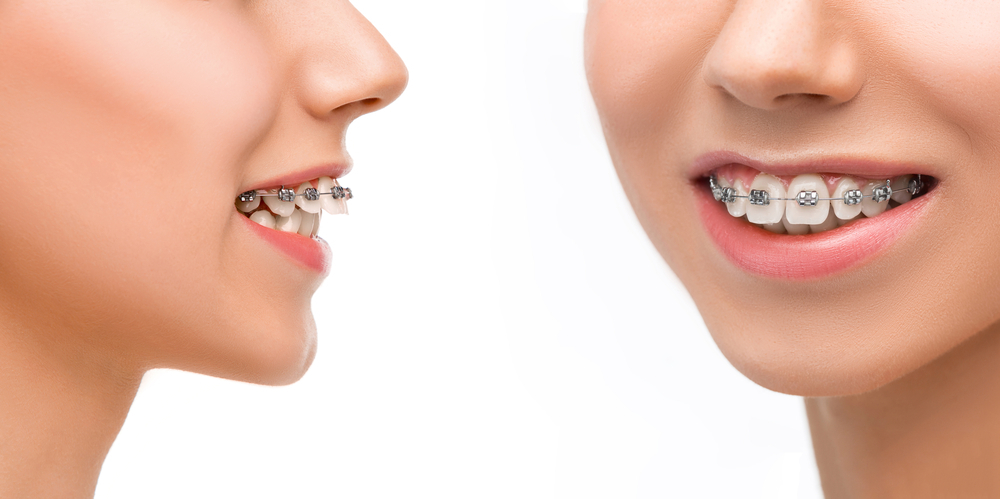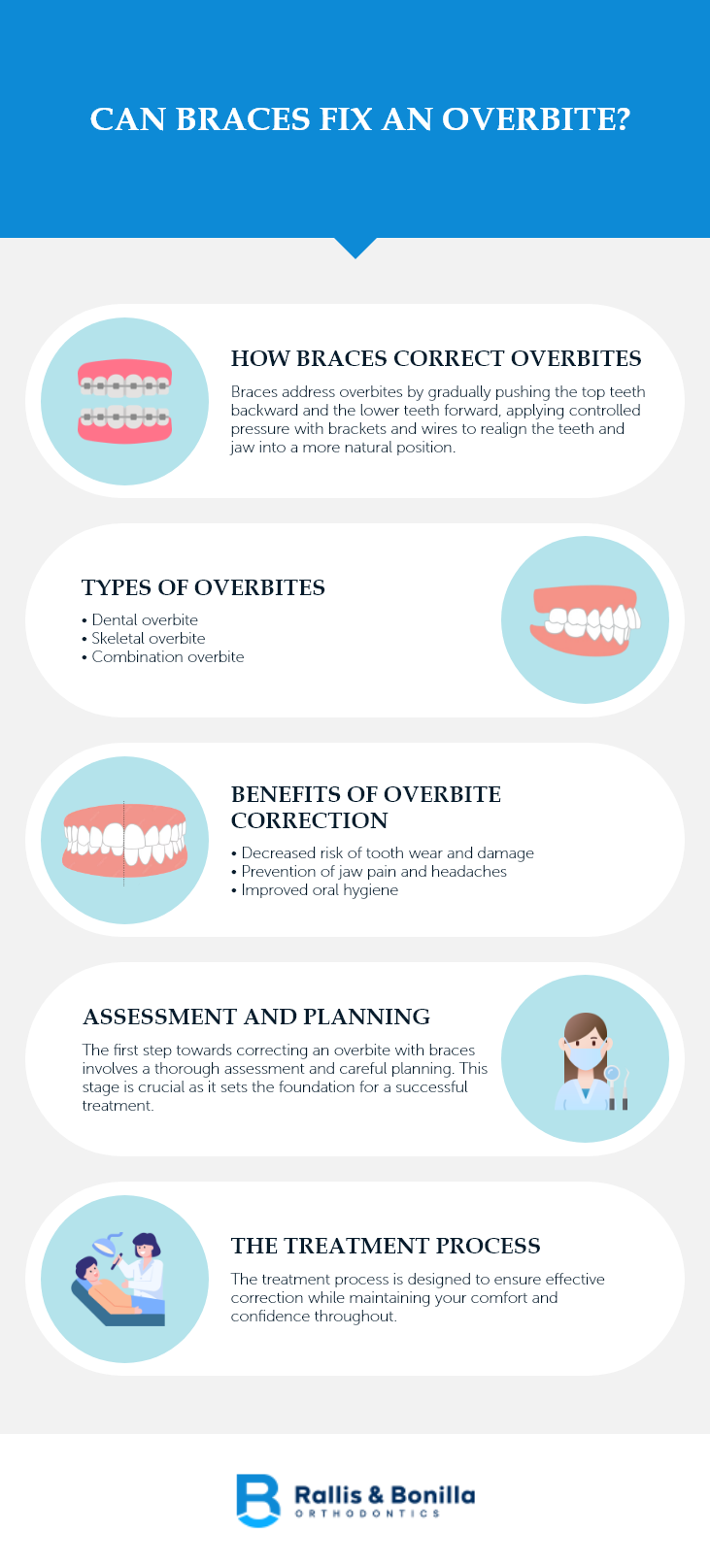An overbite is more than just a cosmetic concern—it can affect your dental health and comfort. Fortunately, braces are a proven solution for correcting an overbite, enhancing both your smile and oral functionality. In this blog post, we’ll explore how braces can adjust your teeth alignment effectively and the process involved. Our aim is to provide you with clear information to help you make an informed decision about pursuing braces as an orthodontic treatment option. Whether you’re considering braces for yourself or a loved one, understanding the benefits and process can make your journey to a healthier smile a confident and positive experience.
How Braces Correct Overbites
Braces are an essential tool not only for enhancing your smile but also for correcting overbites—a common condition where the upper teeth protrude significantly beyond the lower teeth. There are several treatment options available, including traditional metal braces, ceramic braces, and clear aligners like Invisalign. For more complex cases, treatments may extend to orthognathic surgery, bite plates, and splint therapy.
The primary role of braces is to adjust the position of your teeth, ensuring that your upper and lower front teeth align properly when you bite down. The approach to correcting an overbite with braces depends on the underlying cause, whether it’s related to the positioning of the teeth or the misalignment of the jaw. Braces effectively manage various scenarios, such as upper teeth that flare out, lower teeth that are set back too far, or even cases where both teeth and jaw alignment issues are present.
By gradually shifting the teeth into their correct positions, braces not only improve the function of your bite but also contribute to a healthier and more beautiful smile.
Types of Overbites and Braces Treatment
Braces are an effective treatment for different types of overbites, which can vary based on the degree of protrusion and the underlying cause. Understanding how braces correct these variations can help you appreciate the versatility and effectiveness of this treatment option.
- Dental Overbite – This occurs when the teeth are the primary reason for the overbite, rather than the jawbone. The upper teeth extend too far forward over the lower teeth. Braces are applied to realign the teeth into the correct position. Your orthodontist adjusts the braces to move the upper teeth backward and the lower teeth forward, creating a proper bite alignment.
- Skeletal Overbite – This type of misalignment involves the jaw structure, where the upper jaw is too forward compared to the lower jaw. While braces can help realign the teeth for a better bite, additional orthodontic appliances like palatal expanders or surgical options might be needed for severe overbites. Devices that influence jaw growth can be effective for younger patients, while adults might require more comprehensive interventions.
- Combination Overbite – Some overbites involve both teeth misalignment and jaw positioning issues. Treatment usually starts with braces to correct tooth alignment and may involve other devices like elastic bands to apply additional pressure in specific directions, helping to adjust the jaw alignment over time.
Correcting an overbite with braces can significantly improve your smile and oral health. While the journey may seem long, the results are well worth the commitment. We will guide you through each step of the process, ensuring you understand how your treatment is progressing and what to expect. With the right care and dedication, braces can provide a lasting solution to overbite issues, leading to improved dental function and aesthetics.
Benefits of Overbite Correction
Correcting an overbite with braces offers several significant benefits that extend beyond just achieving a more appealing smile. Here’s a closer look at how braces can improve both your dental health and overall well-being:
- Enhanced Chewing and Speech – Braces help align your teeth and jaw, which can improve the mechanics of chewing and speaking. A corrected bite means you can eat more comfortably and speak more clearly, which can boost your quality of life.
- Decreased Risk of Tooth Wear and Damage – An overbite can cause excessive wear on your front teeth, making them more susceptible to chipping and other damage. By aligning your bite, braces help distribute the biting pressure across all your teeth, which reduces the risk of damage and can prolong the health of your teeth.
- Improved Oral Hygiene – Straight teeth are easier to clean. An overbite can make it hard to reach some surfaces of your teeth with a toothbrush or floss, leading to an increased risk of cavities and gum disease. After correcting this misalignment, it becomes much easier to maintain good oral hygiene, helping prevent future dental issues.
- Increased Confidence and Self-Esteem – A straight, well-aligned smile can significantly boost your confidence and self-esteem. Many people find that correcting an overbite gives them a new sense of freedom to smile openly and feel more positive about their appearance.
- Prevention of Jaw Pain and Headaches – An improperly aligned bite can strain your jaw muscles and joints, potentially leading to chronic jaw pain, TMJ disorders, neck pain, or headaches. Braces can relieve this strain by positioning your jaw more comfortably and naturally.
- Improve Sleep Apnea – Proper alignment of the jaw can potentially reduce the risk of airway obstruction and improve breathing patterns during sleep.
Each of these benefits contributes to a healthier mouth and a happier, more confident you. If you’re considering braces for overbite correction, discussing your options with us can set you on the path to a better smile and improved oral health.
Assessment and Planning
The first step towards correcting an overbite with braces involves a thorough assessment and careful planning. This stage is crucial as it sets the foundation for a successful treatment. Here’s what to expect during this initial phase:
- Initial Consultation – Your journey begins with a consultation where we will evaluate your dental and facial structure. This includes a detailed discussion about your dental history and any concerns you might have regarding your smile or bite.
- Diagnostic Tests – To get a clear picture of your teeth and jaw alignment, we utilize our i-CAT Cone Beam 3D imaging system. This technology allows us to get a full 3-dimensional view of the entire face and jaw, allowing for higher accuracy in diagnosing and treatment planning.
- Treatment Planning – Using the information gathered, we will develop a customized treatment plan. This plan will outline the type of braces being used for the correction, the duration of your treatment, and whether other devices are necessary to correct your overbite.
Once you are comfortable with the proposed plan and all your questions have been answered, we will finalize the details. You’ll be informed about the next steps, such as when to begin your overbite treatment and how to prepare.
The Treatment Process
This phase is designed to ensure effective correction while maintaining your comfort and confidence throughout. Here’s what you can expect during your orthodontic treatment process:
The first step is the application of the braces:
- Bracket Placement – Your orthodontist will attach small brackets to each tooth using a dental adhesive. These brackets serve as handles to hold the archwire that moves the teeth.
- Archwire Installation – A thin metal wire, or archwire, is threaded through these brackets. It’s this wire that will be adjusted to apply the correct amount of pressure to realign your teeth and jaw.
- Band Placement – Bands are sometimes placed around the back molars to provide additional support and anchorage for the wire.
As your teeth gradually move, regular visits are necessary to make adjustments:
- Tightening the Braces – Your orthodontist will adjust the archwire and possibly reposition the brackets to ensure continuous and effective movement of the teeth into their correct positions.
- Monitoring Progress – Each visit also allows us to monitor your progress and make any necessary modifications to the treatment plan.
Depending on the severity of your overbite, we may use additional tools to aid in the correction:
- Rubber Bands – Elastic bands may be used to exert more specific forces on the teeth and jaws, helping to align them properly.
- Other Appliances – In some cases, other orthodontic appliances like palate expanders or temporary anchorage devices (TADs) are employed to facilitate the desired movement.
Once your teeth have moved to their proper positions and your bite is corrected, your braces will be removed—a celebratory moment! However, treatment doesn’t stop there. To prevent your teeth from shifting back to their original positions, you’ll likely need to wear a retainer as directed by your orthodontist.
By understanding and actively participating in each stage of the treatment process, you can achieve the best possible outcomes and move confidently toward a healthier, more beautiful smile.
If you’re looking for expert orthodontic care to correct an overbite or improve your smile, look no further than Rallis & Bonilla Orthodontics. With three convenient locations in North Star, 84th Street, and Yankee Hill, we’re committed to providing you with the highest quality care in a warm, supportive environment. Our skilled team at Rallis & Bonilla Orthodontics is eager to help you achieve your best smile using the latest techniques and treatments. Visit us at any of our locations for a personalized consultation, and let us show you how we can transform your smile and boost your confidence.

